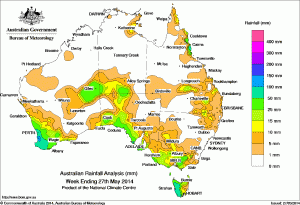The heaviest falls in the past week were recorded in southern parts of WA, SA, Vic and Tasmania, with totals of 50-150mm were measured.
At the start of the week, a cold front crossed the southwest of Australia, bringing moderate falls to a confined area of southwest Western Australia.
The cold front moved eastwards over the Southern Ocean and was associated with a surface and mid-level trough over South Australia early in the week. These synoptic features brought some widespread falls through central South Australia, extending into the Northern Territory.
The cold front continued towards the southern Victorian coast, and approached Tasmania mid-week, bringing some moderate to heavy falls to the Victorian Alps and surrounds, as well as the western half of Tasmania.
The southeasterly trade winds brought moist, onshore flow to exposed parts of the Queensland coast, and an upper level trough over southeastern Queensland generated some moderate to heavy falls over the central and southern Queensland interior during the first half of the week.
A series of cold fronts approached the west coast of Western Australia later in the week, sweeping through the southern mainland of Australia and Tasmania, with some moderate rain falling in their wake.
The highest weekly total of 195 mm was recorded at Mount William on the south coast of Western Australia.
Rainfall totals between 50 mm and 150 mm were recorded in southwest Western Australia, exposed locations in coastal South Australia, the Tasmanian west coast, parts of the Victorian Alps, and in isolated areas of the North Tropical Coast district of Queensland.
Rainfall totals between 15 mm and 50 mm were recorded in areas surrounding higher falls, and extending into southwest Western Australia, coastal South Australia, northern Tasmania and much of Victoria, as well as in central Australia.
Small pockets of Queensland south of Rockhampton, Cape York Peninsula, the eastern Top End and northeastern and southern New South Wales recorded weekly totals of 10 mm to 25 mm.
Central Western Australia, areas of inland New South Wales, northeastern South Australia, southwest Queensland and remaining parts of Australia away from the southern coast, except for the Queensland north tropical coast, received little or no rainfall.
Highest weekly rainfall totals in each state:
| State | Highest | 2nd Highest | 3rd Highest |
|---|---|---|---|
| WA | Mount William (195 mm) (South Coast) |
Dwellingup (143 mm) (South Coast) |
Henty Brook (126 mm) (South Coast) |
| NT | Kulgera (27 mm) (Alice Springs) |
Watarrka (16 mm) (Alice Springs) |
Glen Helen Lodge (15 mm) (Alice Springs) |
| SA | Coffin Bay (57 mm) (Western Agricultural) |
Parndana (Turkey Lane) (53 mm) (Kangaroo Island) |
Cape Borda (51 mm) (Kangaroo Island) |
| Qld | Tree House Creek (99 mm) (Barron) |
Daradgee (93 mm) (Barron) |
South Johnston (91 mm) (Barron) |
| NSW/ACT | Charlotte Pass (27 mm) (Snowy Mountains) |
Thredbo (25 mm) (Snowy Mountains) |
Bukkulla (22 mm) (Northwest Slopes) |
| Vic | Mount Hotham (86 mm) (Upper Northeast) |
Warburton (76 mm) (East Central) |
Falls Creek (68 mm) (Upper Northeast) |
| Tas | Mount Read (133 mm) (West Coast) |
Rosebery (Gepp Street) (103 mm) (West Coast) |
Lake Margaret (102 mm) (West Coast) |
Source: Bureau of Meteorology

